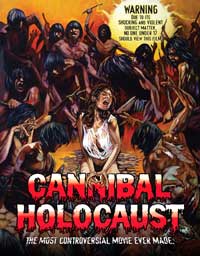 CANNIBAL
HOLOCAUST (1979) Blu-ray
CANNIBAL
HOLOCAUST (1979) Blu-rayDirector: Ruggero Deodato
Grindhouse Releasing
 CANNIBAL
HOLOCAUST (1979) Blu-ray
CANNIBAL
HOLOCAUST (1979) Blu-rayRuggero Deodato's CANNIBAL HOLOCAUST, the one that goes all the way, hits Blu-ray stateside in a sterling three-disc set from Grindhouse Releasing.

In 1976, four young documentary filmmakers – director Alan Yates (Carl Gabriel Yorke, IDLE HANDS), assistant director Faye Daniels (Francesca Ciardi, THE TUNNEL), and cameramen Jack Anders (Perry Pirkanen, CITY OF THE LIVING DEAD), and Mark Tamoso (Luca Barbareschi, THE INTERNATIONAL) – went into the Amazon jungle to make a film about the Yamamomo tribe (the "Tree People"). They were never heard from again. Two years later, NYU anthropologist Harold Monroe (Robert Kerman, DEBBIE DOES DALLAS and EATEN ALIVE) is hired by a TV station to mount an expedition into the jungle in hopes of finding out what became of the filmmakers. With the help of the country's military and guide Chaco (Salvatore Basile, Herzog's COBRA VERDE), they hope to use a captured member of the Yamamomo's enemy tribe to lead them into "The Green Inferno". The natives meet them with a mix of fear and distrust that has Chaco surmising that the filmmakers really made a mess of things, requiring of Monroe a bit of maneuvering – including munching on some proffered human flesh – to lead him to a shrine made up of the skeletonized remains of the filmmakers, their camera equipment, and several film cans. The footage is taken back to New York where the studio's technicians set about attempting to reconstruct the fates of the filmmakers in anticipation of a TV documentary. In the meantime, Monroe sets about interviewing the crew's family and colleagues, revealing a ruthless portrait of Yates, who pushed his crews to the limits and was even rumored to have staged executions in his previous death squad documentary "The Last Road to Hell." As Monroe views the footage, he is horrified and disgusted not with the tribal rites, but with the repellant acts staged and perpetrated by the filmmakers in the name of sensationalism ("the more you rape their senses, the happier they are," a TV executive tells Monroe) as well as what happened the tables turned.
 Mounted,
according to Deodato, as an indictment of Italian TV sensationalistic coverage
of the Red Brigade's assassinations of politicians and other acts of terrorism,
CANNIBAL HOLOCAUST is without doubt the strongest of Italian cannibal films.
Thoroughly grim from start to finish with Kerman's nude frolicking with tribeswomen
as the only brief respite, every other exploitable moment is meant to leave
a bad aftertaste, particularly the animal violence (the crew's evisceration
of a live turtle is more disturbing than the graphic though simulated fates
of the humans). The film has been cited as the inspiration for THE BLAIR WITCH
PROJECT (some have called the latter film a rip-off) and a host of other "found
footage" films since then, and it did provoke the same reaction overseas
with viewers believing Deodato really killed his actors. That the director instructed
his main cast members to disappear for a year after the film's production suggested
that he was more concerned with notoriety than taking a stance against sensationalism.
The film definitely has earned its reputation as an endurance test, approached
simultaneously with curiosity as to whether it lives up to its reputation and
trepidation about what one will really see on the screen. Sergio D'Offizi's
lush photography and Riz Ortolani's heart-wrenchingly beautiful score underlines
the senseless tragedy of the titular holocaust perpetrated by the "real
cannibals". The film was produced by Franco Di Nunzio and Franco Palaggi
who would later produce Deodato's take on LAST HOUSE ON THE LEFT titled THE
HOUSE ON THE EDGE OF THE PARK (also scored by "sweetly" Ortolani and
photographed by D'Offizi). Lamberto Bava (DEMONS) served as assistant director.
Mounted,
according to Deodato, as an indictment of Italian TV sensationalistic coverage
of the Red Brigade's assassinations of politicians and other acts of terrorism,
CANNIBAL HOLOCAUST is without doubt the strongest of Italian cannibal films.
Thoroughly grim from start to finish with Kerman's nude frolicking with tribeswomen
as the only brief respite, every other exploitable moment is meant to leave
a bad aftertaste, particularly the animal violence (the crew's evisceration
of a live turtle is more disturbing than the graphic though simulated fates
of the humans). The film has been cited as the inspiration for THE BLAIR WITCH
PROJECT (some have called the latter film a rip-off) and a host of other "found
footage" films since then, and it did provoke the same reaction overseas
with viewers believing Deodato really killed his actors. That the director instructed
his main cast members to disappear for a year after the film's production suggested
that he was more concerned with notoriety than taking a stance against sensationalism.
The film definitely has earned its reputation as an endurance test, approached
simultaneously with curiosity as to whether it lives up to its reputation and
trepidation about what one will really see on the screen. Sergio D'Offizi's
lush photography and Riz Ortolani's heart-wrenchingly beautiful score underlines
the senseless tragedy of the titular holocaust perpetrated by the "real
cannibals". The film was produced by Franco Di Nunzio and Franco Palaggi
who would later produce Deodato's take on LAST HOUSE ON THE LEFT titled THE
HOUSE ON THE EDGE OF THE PARK (also scored by "sweetly" Ortolani and
photographed by D'Offizi). Lamberto Bava (DEMONS) served as assistant director.
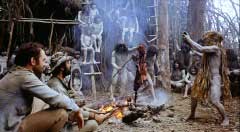
Unreleased on VHS in the United States following it's theatrical release via Transcontinental (after United Artist dumped the title, although they distributed it in Europe), CANNIBAL HOLOCAUST was widely available on the grey market as dubs from the Japanese laserdisc and tape, and various other European sources. The film made it to DVD in several other countries in varying degrees of completeness (including censored versions from UK company Vipco) before Grindhouse announced their DVD (after which Substance put out a DVD port of the nineties Cult Epics laserdisc). Although late in coming, Grindhouse's two-disc DVD edition was packed to the gills with extras and sported a high definition-mastered (although interlaced) transfer with stereo remix and original mono audio tracks. It offered uncut and animal cruelty-free cuts of the film via branching. An Italian special edition followed carried over some of the extras but featured a different Italian-language commentary, a 5.1 Italian mix, and an isolated score track.
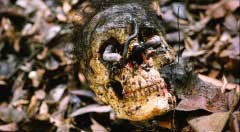 Shameless
Screen Entertainment in the UK beat Grindhouse to the punch with their region
free Blu-ray release, derived from a new HD master – opening with the
United Artist TransAmerica logo also seen on DEADLY BLESSING – that was
brighter and somewhat flatter. Like the Grindhouse, it offered two versions.
The original version (96:02), however, was compromised fifteen seconds cuts
as well as substitutions by the BBFC (who previously banned it as a "Video
Nasty", before allowing cut versions through on DVD from Vipco missing
over five minutes of animal cruelty and "eroticised sexual violence")
while the "Reduced Animal Cruelty" (95:49) version was newly created
by Deodato. This release did offer the participation of actor Ciardi, who was
not present on the Grindhouse DVD extras, as well as some worthwhile extras
relevant to the film's history of censorship in the UK (at least they got it
on home video as stateside it was announced by Mogul who then went out of business
before it was released).
Shameless
Screen Entertainment in the UK beat Grindhouse to the punch with their region
free Blu-ray release, derived from a new HD master – opening with the
United Artist TransAmerica logo also seen on DEADLY BLESSING – that was
brighter and somewhat flatter. Like the Grindhouse, it offered two versions.
The original version (96:02), however, was compromised fifteen seconds cuts
as well as substitutions by the BBFC (who previously banned it as a "Video
Nasty", before allowing cut versions through on DVD from Vipco missing
over five minutes of animal cruelty and "eroticised sexual violence")
while the "Reduced Animal Cruelty" (95:49) version was newly created
by Deodato. This release did offer the participation of actor Ciardi, who was
not present on the Grindhouse DVD extras, as well as some worthwhile extras
relevant to the film's history of censorship in the UK (at least they got it
on home video as stateside it was announced by Mogul who then went out of business
before it was released).
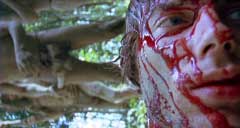
CANNIBAL HOLOCAUST is Grindhouse's first Blu-ray reissue of one of their earlier DVD releases, and the 1080p24 MPEG-4 AVC 1.85:1 encode of a new HD master reflects the color and contrast choices of their earlier HD master for the DVD release, preserving the warmer tones of the 16mm found footage (while the master used for the Shameless edition attempted a more naturalistic color timing). A wealth of new details is visible (or at least more evident the first time around). The Amazon River and various lakes and ponds under the opening credits aerial shot vividly reflect the sky, every spec of jungle debris that has affixed itself to the camera lens can be seen, and it's obvious that the cameraman got very close to the jaguar in one shot not just by the depth of field but also the now apparent fogging of the lens when the cat roars. The New York scenes are quite beautiful-looking as well, as if Deodato and crew treated the places with the same reverence and exoticism as Columbia. Audio options include the film's original English – all of the leads perform in English (although Yorke's on-set/location audio seems to be the only one used while even Kerman is dubbed by familiar voice actor Edward Mannix, while some spoken Spanish in the Columbian scenes is translated with new burnt-in subtitles – mono track in DTS-HD Master Audio 1.0 as well as the stereo remix Grindhouse created for the DVD – now in DTS-HD Master Audio 2.0 – with dialogue, screaming, and Ortolani's score coming through forcefully. The film can be viewed in its original uncut version (95:44) – well, well, minus a few seconds from "The Last Road to Hell" sequence that appear in some prints of the film, and is offered up here as an extra (1:46) with alternate credits that had to be changed when the character names were changed in the script (Faye's character was called "Shanda Tomasso"), and the filmed but apparently never included piranha sequence (the script pages of which are available in an Easter Egg) – and the "Animal Cruelty-Free" (90:34) edit via branching.
 The
film can be viewed with two audio commentaries: the first with Deodato and Kerman
recorded for the original DVD release, and a new one with Yorke and Ciardi (moderated
sparingly by High Rising Productions' Calum Waddel and Italian horror enthusiast
Mike Baronas (the man behind some of Blue Underground's featurettes for their
Lucio Fulci Blu-rays of late). Deodato is a bit cagey about the animal violence
– but he admits that his feelings have changed since then – as well
as when Kerman needles him about the brothel where they supposedly found the
girls for Kerman's nude dip in the Amazon River. Kerman is a more self-conscious
about his acting (although on the second commentary track, Yorke – who
did not know Kerman was a porn actor until seeing him sign copies of DEBBIE
DOES DALLAS at the Chiller festival – observes that he is quite good in
assessing his nonverbal performance since they are watching with the sound down)
but is generally good-humored; although he isn't afraid to call Deodato out
on some of his questionable choices as a director (especially during the turtle
scene since he has a pet tortoise). He points out the New York locations, and
reveals that the actress who plays the TV executive was his girlfriend at the
time.
The
film can be viewed with two audio commentaries: the first with Deodato and Kerman
recorded for the original DVD release, and a new one with Yorke and Ciardi (moderated
sparingly by High Rising Productions' Calum Waddel and Italian horror enthusiast
Mike Baronas (the man behind some of Blue Underground's featurettes for their
Lucio Fulci Blu-rays of late). Deodato is a bit cagey about the animal violence
– but he admits that his feelings have changed since then – as well
as when Kerman needles him about the brothel where they supposedly found the
girls for Kerman's nude dip in the Amazon River. Kerman is a more self-conscious
about his acting (although on the second commentary track, Yorke – who
did not know Kerman was a porn actor until seeing him sign copies of DEBBIE
DOES DALLAS at the Chiller festival – observes that he is quite good in
assessing his nonverbal performance since they are watching with the sound down)
but is generally good-humored; although he isn't afraid to call Deodato out
on some of his questionable choices as a director (especially during the turtle
scene since he has a pet tortoise). He points out the New York locations, and
reveals that the actress who plays the TV executive was his girlfriend at the
time.
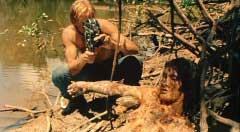
Yorke has not actually sat down to watch the film before other than fast-forwarding through a bootleg tape of it in the nineties and seeing clips since then. Ciardi is more familiar with the film although she occasionally misidentifies scenes and characters. Together they talk about the shoot and help each other recollect details. Strangely, it seems that toughing it out through the weather, the water, and hazards of the jungle were not as much an endurance test as working with Deodato who they describe as abusive during the shooting but nice in the interim and in subsequent meetings. They are appalled by the animal violence but less so with the simulated human violence, but this seems less hypocritical than fan reactions because they were at first under the impression it would be faked like the cannibalism scenes and that their death scenes at the hands of the cannibals were not as traumatic to shoot as they look on camera (Ciardi describes the extras as "gentle" and finds the finished scene harder to look at than it was to act out). Ciardi provocatively dismisses Deodato's court summons in Italy – in which he had to prove that he did not really kill the actors – as a way of generating free publicity. Language and personalities distanced them from their two co-stars, but they both speak warmly of actor/assistant director Basile – now famous in Columbia as a telenovela actor – who was not only one of the few English-speaking locals involved in the production but also acted as unofficial guide. Ciardi also reveals that she angered Deodato when she turned down a role in THE HOUSE ON THE EDGE OF THE PARK. Waddel and Baronas actually contribute very little to the track, serving to prompt the actors in the few lulls rather than interjecting trivia on the cannibal genre.
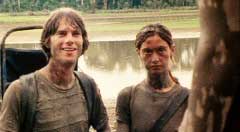 The
Grindhouse Blu includes several extras from the 2-disc DVD edition and several
newer extras, but some extras from the earlier edition have been noticeably
dropped. The hour-long documentary "In the Jungle" is nowhere to be
found, as is the on-camera commentary in which video segments from the Kerman/Deodato
track would pop up throughout the feature. The English language screenplay isn't
on the disc, but it is available on the www.cannibalholocaust.net
website if you enter the password provided in the booklet. A Criterion-esque
booklet reproduction of the script might have been a nice extra, but it probably
would have driven up the release price. The first disc also includes the same
selection of trailers for the film as the DVD: international (3:06), Italian
(3:09), German (2:12) – titled NACKT UND ZERFLEISCHT ("Naked and
Mauled"), and the only one that doesn't simply "cannibalize"
the international/Italian trailer – and original U.S. (1:25) and re-release
trailers (1:59).
The
Grindhouse Blu includes several extras from the 2-disc DVD edition and several
newer extras, but some extras from the earlier edition have been noticeably
dropped. The hour-long documentary "In the Jungle" is nowhere to be
found, as is the on-camera commentary in which video segments from the Kerman/Deodato
track would pop up throughout the feature. The English language screenplay isn't
on the disc, but it is available on the www.cannibalholocaust.net
website if you enter the password provided in the booklet. A Criterion-esque
booklet reproduction of the script might have been a nice extra, but it probably
would have driven up the release price. The first disc also includes the same
selection of trailers for the film as the DVD: international (3:06), Italian
(3:09), German (2:12) – titled NACKT UND ZERFLEISCHT ("Naked and
Mauled"), and the only one that doesn't simply "cannibalize"
the international/Italian trailer – and original U.S. (1:25) and re-release
trailers (1:59).
The wealth of new material is certainly welcome, but the omission of the "In the Jungle" featurette deprives the set of some context for the film's reputation with only mentions of Deodato's prosecution and the banning of the film in several countries spread out among the extras as side remarks. The new 2011 Deodato interview (58:08) goes some way into rectifying that issue. It is divided into three parts, with the director discussing his experiences on his three cannibal films: LAST CANNIBAL WORLD/JUNGLE HOLOCAUST (1977), CANNIBAL HOLOCAUST (1978), and CUT AND RUN (1985). Of CANNIBAL HOLOCAUST, he discusses the concept he put together with screenwriter Gianfranco Clerici (THE NEW YORK RIPPER), his interest in showing the Indios as the good guys, the reaction of the financiers after screening rushes at MIFED and pre-selling it to United Artists ("Kill everyone and everything!"), it's perception as a snuff film upon release and having to bring Ciardi in to prove that he had not killed his actors, and the court's subsequent prosecution of him for the animal killings (linked to a law that prevented the introduction of Spanish bullfighting into Italy) which he defends by the fact that the animals were the kind the Indios killed and ate on a regular basis (indeed the animals killed on film were fed to them). He also discusses the power of the film's soundtrack, and the use of sentimental music as a contrast to the violence onscreen citing Ortolani's score for MONDO CANE (as well as taking the same approach with Ortolani on HOUSE ON THE EDGE OF THE PARK).
Francesca Ciardi's interview (38:21) features a lot of overlap with the commentary track, but the interview was recorded four years ago (presumably it is footage from which her participation was extracted for one of the Shameless Blu-ray featurettes). Actor/production manager Salvatore Basile appears in a brand new 2014 interview (30:32), describing the job as an adventure, and a "master class in special effects" for him, and the trouble with the local journalist who thought they were really killing natives. He discusses how he got into films, his early roles and behind the camera work (including 1968 film GUNGALA, THE PANTHER GIRL), and casting the Ticuna people (who had already been providing entertainment for tourists so they were enthusiastic about being film extras). Camera operator Robert Forges Davanzati (12:31) recalls shooting the 16mm footage (the onscreen cameras had no film in them, and he would change places with the actor who is supposedly offscreen filming what we see onscreen), and how just getting the equipment to the locations was more difficult than the actual shooting.
The next featurette features Deodato at the Cinema Wasteland panel in 2011 (28:22) alongside Yorke and Ciardi, Michael Berryman (who was in his CUT AND RUN), and David Hess (from THE HOUSE ON THE EDGE OF THE PARK) in which makes some humorous (and possibly offensive) remarks about working with each of them before discussing CANNIBAL HOLOCAUST (including how some of the setpieces were invented on the fly after United Artists' reaction to the rushes at MIFED). Yorke tells the story of how he wasn't the first to be cast in the lead, while Ciardi answers a question about the atmosphere on set during the animal violence scenes, and Deodato relates the story of how Yorke did not want to shoot the pig in the village scene and also addresses questions about a sequel to CANNIBAL HOLOCAUST. Ciardi – who now lives in London and was thus accessible for the Shameless extras – appears again in a 2010 Q&A at a film festival in Glasgow (11:14) in which the audience questions are subtitled. Ciardi once again answers questions about the animal violence – it really is an inevitable topic in any discussion of the film – how she came to Deodato's attention since she was at school with his sister, working on location, and how she feels about the film – which she left off her CV for some time – and Deodato himself since then (including her regret that she didn't do THE HOUSE ON THE EDGE OF THE PARK).
The interview section is rounded out by convention reunions between Yorke and Deodato Reunion in 2009 (10:25) and Kerman and Deodato Reunion in 2000 (8:48). Also carried over from the DVD edition on the second Blu-ray disc are the interviews with actors Kerman (35:35) – who recalls how he got involved with Deodato first with THE CONCORDE AFFAIR and is candid in his opinion of the director's treatment of the cast and crew – and Yorke (51:13) which features a lot of the same stories as the commentary (understandable since this interview dates from 2005). Also carried over is the shorter interview with composer Ortolani (4:58) in which he recalls being contacted by Deodato to score the film, seeing a workprint, the score's mix of orchestra and electronics, and its melancholy tone. The still galleries section is quite extensive, including ninety-seven production stills, thirty-four behind-the-scenes images, over a hundred scans of promotional materials, sixty-five video and DVD release scans including a Turkish one that uses artwork from the Australian slasher NIGHTMARES, a Thai one that uses stills from CANNIBAL FEROX, and releases of the film AMAZONIA titled CANNIBAL HOLOCAUST 2 (the gallery does not include any of the other in-name-only sequels and follow-up retitlings like Antonio Climati's THE GREEN INFERNO, Bruno Mattei's LAND OF DEATH, or even MYA's boneheaded retitling of the already insulting mondo movie NEW GUINEA, ISLAND OF THE CANNIBALS as THE REAL CANNIBAL HOLOCAUST). "Mondo Cannibal" includes over seventy photos of posters on buildings and movie marquees around the world.
The second disc also includes trailers for CANNIBAL FEROX, THE BEYOND, PIECES, AN AMERICAN HIPPIE IN ISRAEL, CORRUPTION, THE BIG GUNDOWN, THE SWIMMER, MASSACRE MAFIA STYLE, GONE WITH THE POPE, ICE HOUSE, SCUM OF THE EARTH, CAT IN THE BRAIN, THE TOUGH ONES, and I DRINK YOUR BLOOD. The Blu-ray Production Credits screen is signed in memory of the film's original U.S. distributor after UA dumped it Larry Joachim (who also distributed the BREAKER BREAKER, BLACK SAMURAI, and several Sonny Chiba and kung fu movies). Housed in a cardboard sleeve inside the slipcase alongside the Blu-ray case is a ten-track CD of Riz Ortolani's score (32:37) that appears to be the same in content to the retail releases. A twenty-four page liner notes booklet includes an essay by Eli Roth, another by Chas. Balun, an essay on the score by Gergely Hubai, a comparison of the film and script by Martin Beine, a chapter listing for the film, and the center unfolds to reveal a "centerfold" of the impaled woman. A Grindhouse Releasing disc wouldn't be one without its share of Easter Eggs, and there are nine on CANNIBAL HOLOCAUST; including the script pages from the "Lost Piranha Scene", a typically terrible Necrophagia music video, an outtake from the Basile interview, video from the commentary track where Kerman and Deodato address the animal cruelty,footage from two of the world re-release premiere and a Vancouver screening, video of the interviewers catching up with Yorke for the first time, and a trailer for the popular Robert Kerman title DEBBIE DOES DALLAS. (Eric Cotenas)